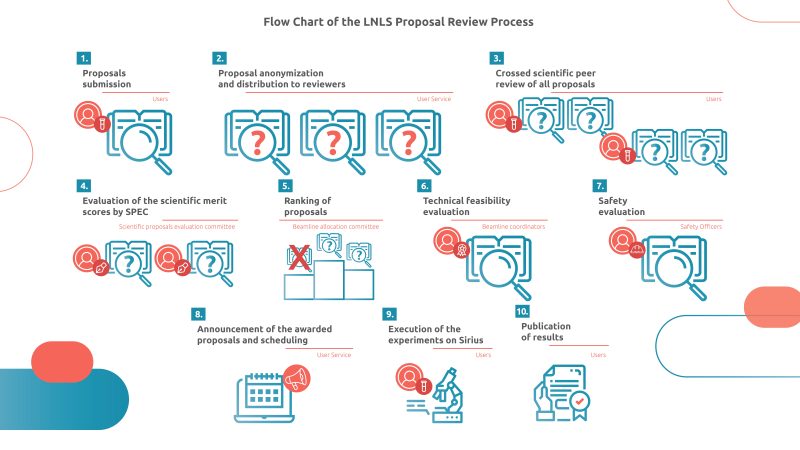
The third call for research proposals at Sirius will take place from August 15th to September 6th, 2023.
Alongside the 6 research stations already operating, 4 new beamlines will begin to receive regular proposals during this call
Sirius, the new Brazilian synchrotron light source planned and operated by the Brazilian Center for Research in Energy and Materials (CNPEM), an organization supervised by the Ministry of Science, Technology and Innovation (MCTI), has opened its third regular call for proposals for research to be conducted in its first ten experimental stations.
Researchers who are interested in conducting experiments at Sirius may submit proposals from August 15 to September 6. The research from the proposals selected during this call will be conducted during the first half of 2024.
There is no cost for academic use. Researchers from Brazilian and foreign institutions living in Latin America and the Caribbean whose projects are approved may request financial aid to travel to Campinas, São Paulo, where Sirius is located, and use the facilities there.
The beamlines that are now receiving proposals during this call have further broadened the experimental possibilities at Sirius. According to LNLS Director Harry Westfahl Jr., other types of experiments can be conducted to supplement work currently underway: “In the Cedro beamline we will offer new experimental possibilities for research in biophysics, while in the Sabiá beamline we will have more possibilities to reveal the mechanisms that grant materials their magnetic properties. Mogno, the beamline at Sirius with the highest energy, will offer unprecedented capacities in X-ray tomography to benefit various knowledge areas. Finally, the Paineira beamline will expand our capacity in crystallography and offer opportunities for soil minerology and to investigate the atomic structure of catalysts in real time.”
Furthermore, the Ipê line, which is open for research, will offer a new technique: resonant inelastic X-ray scattering (RIXS). “This technique is available at few of the world’s synchrotron light sources and makes it possible to determine how electrons organize to provide properties ranging from catalytic centers in biomolecules to the formation of exotic states of matter, as in superconductive materials,” explains Westfahl Jr.
Cedro: Circular dichroism (CD) spectroscopy in the ultraviolet (UV) range. This technique based on differential absorption of circularly polarized light allows structural analysis of optically active materials such as proteins, nucleic acids, and carbohydrates. This technique makes it possible to quantify the contents of protein secondary structures such as alpha helices, beta sheets, and disordered structures, as well as to study other types of materials that demonstrate chirality. The high proton flux provided by Sirius ensures greater sensitivity and a more extensive band of wavelengths, reaching the vacuum ultraviolet region (<200 nm), which is normally inaccessible using conventional light sources.
Mogno: X-ray micro- and nanotomography. Initially configured to operate at near-monochromatic energy of 22 keV, the Mogno beamline offers the ability to acquire tomographic images as well as zoom mode, making it possible to create imagery for the same sample at different spatial resolutions. Its applications cover various disciplines including geology, biology, materials science, agriculture, civil engineering, paleontology, archeology, and other related areas.
Paineira: X-ray diffraction of polycrystalline materials (PXRD). This beamline is temporarily operating with X-rays produced by a wiggler and fixed energy of 20 keV; over the next year, installation of the undulator as well as the conclusion of commissioning for the monochromator will allow the photon flux to increase by up to 100 times and operate at 5 to 30 keV. The Paineira beamline was designed to optimize experimental time involving synchrotron light and includes automatic sample changes using a robotic arm connected to a magazine containing up to 320 samples. Additionally, this operating mode (known as high-throughput) permits measurements not only at room temperature, but also temperature variations from –180 °C up to 300 °C. The beamline also has a capillary cell which can heat a sample up to 850 °C and add a flow of inert gas or synthetic air during acquisition of the X-ray diffraction patterns. In the future, a wider variety of gases, as well as liquid, vapor, and increased pressure, will be available for experiments involving in situ and operando conditions.
Sabiá: Soft X-ray absorption spectroscopy and photoemission microscopy. The Sabiá beamline contains an undulator with polarization control, which allows users to analyze the crystalline structure of materials that exhibit natural or magnetic linear dichroism, such as the surfaces of thin and multilayer films. Materials that exhibit a non-zero magnetic moment may be analyzed according to the difference in circularly polarized X-ray absorption spectra when subjected to a magnetic field (XMCD). The beamline also makes it possible to obtain images with spatial resolution on nanometer length scales, using photoelectron emission microscopy (PEEM) techniques.
Along with the new lines available at the Brazilian Synchrotron Light National Laboratory, the lines that are already operating will continue to receive research proposals during this new call.
Carnaúba: Micro and nano-florescence and X-ray spectroscopy and ptychography. This station analyzes a wide variety of nano-structured material, aiming to obtain 2D and 3D imaging with nanometric resolution of the composition and structure of rocks, soils, biological and technological materials, with the possibility of in situ studies under various environmental conditions.
Cateretê: Coherent diffraction imaging (ptychography) and X-ray photon correlation spectroscopy (XPCS). This station is optimized for 3D imaging with nanometric resolution of materials for a broad array of applications.
Ipê: X-ray Absorption Spectroscopy (XAS), Photoelectron Spectroscopy (XPS) and Resonant Inelastic X-ray Scaterring (RIXS). This beamline combines techniques for surface and interface analysis of materials and molecular systems. It is applied to the study of chemical composition, electronic structure, and elementary excitations in materials with various applications, such as chemical transformations, energy conversion, and information technology.
Ema: High-pressure X-ray spectroscopy and diffraction. The techniques offered in this beamline allow researchers to investigate materials subjected to extreme temperatures, pressures, or magnetic fields. Research on matter subjected to such conditions may reveal new properties with characteristics that do not exist under normal ambient conditions. This is the case for superconductive materials, for example, which can conduct electrical currents without resistance and have the potential to revolutionize energy transmission and storage.
Imbuia: Micro and nano-synchrotron infrared spectroscopy. This experimental station is dedicated to experiments using synchrotron light in the mid-infrared (mid-IR) range, enabling the identification of multidisciplinary materials through their molecular identities and respective vibrational signatures. The multiscale analysis (micro and nano) allows access to the chemical composition of specific structures and interfaces in any mid-IR active material.
Manacá: Macromolecular crystallography (MX). This line features equipment that reveals 3D structures of proteins, enzymes and small molecules with atomic resolution, showing the position of each atom that comprises a certain protein and its functions and interactions with other molecules, such as those used as active components in new medications.
Research proposals for Manacá and Cedro beamlines are “fast tracked“: submissions for research on this beamline are evaluated and accepted on an ongoing basis without interruption.
Just like in previous calls, research proposals will be evaluated through a distributed evaluation system with double anonymity, where all the proposers of the call are also potential reviewers for the same call, within their areas of expertise. At least five reviewers assess each proposal.

The Brazilian Center for Research in Energy and Materials (CNPEM), a private non-profit organization under the supervision of the Ministry of Science, Technology, and Innovations (MCTI), provides a sophisticated and vibrant environment for research and development that is unique in Brazil and is found in few scientific centers in the world. The Center operates four National Laboratories and is the birthplace of the most complex project in Brazilian science – Sirius – one of the world’s most advanced synchrotron light sources. CNPEM brings together highly specialized multi-thematic teams, globally competitive laboratory infrastructures open to the scientific community, strategic lines of investigation, innovative projects in partnership with the productive sector, and training of researchers and students. The Center is an environment driven by the search for solutions with impact in the areas of Health, Energy and Renewable Materials, Agriculture and Environment, and Quantum Technologies. Through the CNPEM 360 Platform, it is possible to explore, in a virtual and immersive way, the environment and activities of the Center; visit https://pages.cnpem.br/cnpem360/. As of 2022, with the support of the Ministry of Education (MEC), CNPEM expanded its activities with the opening of the Ilum School of Science. The interdisciplinary higher course in Science, Technology, and Innovation adopts innovative approaches to provide excellent, free, full-time training with immersion in the CNPEM research environment.
Contact form - Submit your doubt about the call for proposals
A joint effort, involving local and external researchers, validated crystallographic study of small molecules, alongside the usual with proteins
100 new projects will be carried out in the six research stations already open to users in Brazil's largest scientific infrastructure